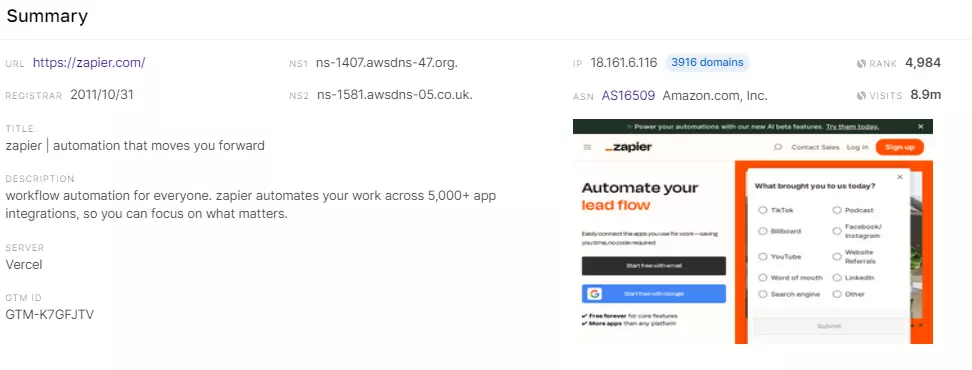
If you find yourself overwhelmed by the multitude of apps, struggling to keep track of the information they generate, Zapier is here to assist.
When an event occurs in an infrequently used app, Zapier can seamlessly send automatic notifications to a more frequently utilized app, ensuring that you stay informed and in control.
This comprehensive Zapier review will delve into the key features, benefits, and potential drawbacks of Zapier to help you understand how it can revolutionize the way you work.
What is Zapier?
Zapier is an online automation tool that connects your favorite apps, such as Gmail, Slack, Mailchimp, and more than 3,000 others.
It allows you to automate workflows by creating "Zaps," which are automated workflows triggered by specific events in one app that result in actions in another.
In essence, Zapier acts as a bridge between different apps, facilitating seamless data transfer and task automation.
Established in 2011, Zapier now has 8.9 million visitors per month.

How Does Zapier Work?
Zapier operates by enabling the creation of workflows, referred to as Zaps, that automate tasks across various software applications. Each Zap comprises a trigger and one or more associated actions.
When the trigger event transpires within a specific app, Zapier seamlessly takes on the role of another app.
For instance, the occurrence of receiving an email (acting as the trigger) can automatically prompt the action of saving the attachment to your Dropbox.
Key Features of Zapier

Here are some key features of Zapier.
1. Extensive App Integration
Zapier's strength lies in its vast library of supported apps. From popular productivity tools to industry-specific software, Zapier integrates with a wide range of applications.
This versatility ensures that users can automate workflows across various platforms, making it a valuable asset for businesses with diverse software ecosystems.
2. User-Friendly Interface
One of Zapier's standout features is its intuitive and user-friendly interface. Setting up Zaps does not require coding expertise, making it accessible to users with varying technical backgrounds.
The drag-and-drop interface simplifies the process of creating automated workflows, allowing users to focus on defining triggers and actions rather than navigating complex technicalities.
3. Multi-Step Zaps
For more complex workflows, Zapier offers multi-step Zaps. This feature enables users to string together multiple actions and conditions within a single Zap.
This capability is particularly valuable for intricate processes that involve several steps across different applications.
4. Trigger-Action Automation
Zapier operates on a trigger-action mechanism. When a predefined trigger event occurs in one app, Zapier initiates a set of actions in another app.
This automation can range from sending emails and creating calendar events to updating spreadsheets or generating reports. The flexibility to design custom workflows empowers users to tailor automation to their specific needs.
5. Filters and Conditions
Zapier provides filters and conditions that allow users to specify criteria for when a Zap should or should not run.
This level of customization ensures that automation is triggered only under specific circumstances, adding a layer of control and precision to the workflow.
6. Task History and Monitoring
Users can track the performance of their Zaps through the task history feature.
This provides insights into when Zaps ran, what actions were taken, and whether any errors occurred. Monitoring capabilities contribute to the transparency and reliability of automated processes.
Benefits of UsingZapier
1. Time and Resource Efficiency
Zapier's primary benefit is the significant time and resource savings it offers. By automating repetitive tasks, users can redirect their focus to more strategic and high-value activities. This increased efficiency is particularly advantageous for small businesses and individuals with limited resources.
2. Enhanced Collaboration
Zapier fosters collaboration by ensuring that information seamlessly flows between different apps used by teams. Integrating communication tools, project management platforms, and file-sharing applications promotes a cohesive and connected work environment.
3. Error Reduction
Automation with Zapier minimizes the risk of manual errors associated with repetitive tasks. The consistent execution of workflows reduces the likelihood of data entry mistakes and ensures accuracy in data transfer between applications.
4. Scalability
As businesses grow and adopt new tools, Zapier scales effortlessly. Its extensive app directory accommodates the evolving needs of organizations, allowing them to integrate additional apps into existing workflows without major disruptions.
5. Accessibility
The simplicity of Zapier's interface makes automation accessible to users with diverse technical backgrounds. This democratization of automation empowers individuals and teams to implement efficient workflows without relying on dedicated IT support.
Drawbacks of Zapier
1. Cost Considerations
While Zapier offers a free plan with limited Zaps and tasks, more robust automation needs may require a subscription to a paid plan. For businesses with extensive automation requirements, the cost of a premium plan should be factored into the overall budget.
2. Dependency on App APIs
Zapier's functionality is contingent on the availability and reliability of APIs (Application Programming Interfaces) provided by the integrated apps. Changes or limitations in an app's API can impact the effectiveness of associated Zaps.
3. Learning Curve for Complex Zaps
While creating basic Zaps is straightforward, designing multi-step Zaps with intricate conditions may pose a learning curve for users unfamiliar with automation concepts. Users may need some time to fully harness the platform's advanced capabilities.
Conclusion on Zapier Reviews
Zapier stands as a powerful and versatile automation tool that empowers individuals and businesses to optimize their workflows.
With its extensive app integration, user-friendly interface, and customizable automation options, Zapier has become a staple in the toolkit of those seeking efficiency and productivity gains.
While it's essential to consider potential drawbacks such as cost and API dependencies, the benefits of time savings, enhanced collaboration, and error reduction make Zapier a valuable asset for streamlining processes in diverse industries. As businesses continue to embrace digital transformation, Zapier remains a frontrunner in the realm of automation, promising to reshape the way we work and collaborate in the digital age.

